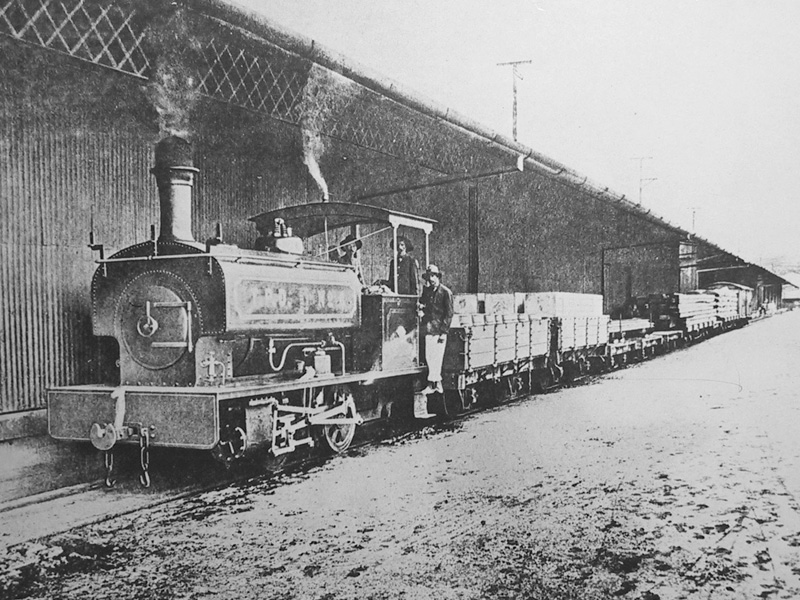
Industrial Railways in Singapore
In addition to the Singapore Tramways, Singapore Government Railway (later the Federated Malay States Railway) and the Military Railways there were also several industrial concerns who operated their own systems over the years. Perhaps the earliest was the Tanjong Pagar Dock Company, who in 1894 acquired the steam trams from the failed Singapore Tramway venture. There were also contractors, such as John Aird & Co., Topham, Jones & Railton and Sir John Jackson who had contracts to build harbours, airfields, the causeway, etc. Then there were smaller concerns who operated quarries, factory sidings etc. It should come as no surprise therefore that there may have been upwards of a hundred steam locomotives operating in Singapore during the first half of the 20th century. Click here for my current listing. Following is a list of the various concerns which will be followed by any data which I have on them.
Tanjong Pagar Dock Company (1865 to 1905)
Tanjong Pagar Dock Board (1905-1912)
Singapore Harbour Board (1912 to 1964)
Port of Singapore Authority (1 April 1964 to 1996).

Above: A Tanjong Pagar Dock company locomotive with a loaded train alongside one of the godowns. A framed print of this picture is in the KTM museum at KLO with the caption "Scenery at Tanjong Pagar Warehouse at Singapore on 1928". This could an R. Stephenson 0-4-0ST.
The Tanjong Pagar Dock Company was formed in 1865. An 1870 photograph shows what appear to be railway tracks but the earliest record I have is of the Tanjong Pagar Docks Tramway in newspaper articles posted by the Tanjong Pagar Docks Company on a regular basis from 1877 onward as per the following sample:
SDT18771107P4 Tanjong Pagar Dock Tramway
https://eresources.nlb.gov.sg/newspapers/Digitised/Article/singdailytimes18771107-1.2.12.1
“COAL SHEDS.—Substantially built of brick and roofed with tiles and capable of storing 50,000 tons of Coal are erected in the immediate rear of the Wharf affording unusual facilities for the discharge of Cargoes and for the supply of steamers; this work is accelerated by the service of a double line of Tramway laid down the whole length and in front of the sheds and by the use of trucks drawn by a locomotive engine.”…
“E. M. SMITH, Manager, Singapore, 5th November 1877.”
3 more samples of the above from different years with only minor differences. These appeared regularly in many newspapers. They confirm the Dock Tramway was in use from 1877 when the locomotives were delivered according to the manufacturers records.
SDT18790419P4 Tanjong Pagar Dock Tramway
https://eresources.nlb.gov.sg/newspapers/Digitised/Article/singdailytimes18790419-1.2.21.1 “COAL SHEDS.—Substantially built of brick and roofed with tiles and capable of storing 50,000 tons of Coal are erected in the immediate rear of the Wharf affording unusual facilities for the discharge of Cargoes and for the supply of steamers; this work is accelerated by the service of a double line of Tramway laid down the whole length and in front of the sheds and by the use of trucks drawn by a locomotive engine.”…
“E. M. SMITH, Manager, Singapore, 5th November 1877.”
SDT18800304P4 Tanjong Pagar Dock Tramway Coal storage increased to 100,000 tons.
https://eresources.nlb.gov.sg/newspapers/Digitised/Article/singdailytimes18800304-1.2.22.1
“COAL SHEDS.—Substantially built of brick and roofed with tiles and capable of storing 100,000 tons of Coal are erected in the immediate rear of the Wharf affording unusual facilities for the discharge of Cargoes and for the supply of steamers; this work is accelerated by the service of a double line of Tramway laid down the whole length and in front of the sheds and by the use of trucks drawn by a locomotive engine.”…
“E. M. SMITH, Manager, Singapore, 1st February 1880.”
STW18831208P15 Tanjong Pagar Docks Tramway
https://eresources.nlb.gov.sg/newspapers/Digitised/Article/stweekly18831208-1.2.5.30
“COAL SHEDS.—Substantially built of brick and roofed with tiles and capable of storing 100,000 tons of Coal are erected in the immediate rear of the Wharf affording unusual facilities for the discharge of Cargoes and for the supply of steamers; this work is accelerated by the service of a double line of Tramway laid down the whole length and in front of the sheds and by the use of trucks drawn by a locomotive engine.”…
Dick & Stevenson supplied two 0-4-0ST shunters numbered 1 & 2 to Tanjong Pagar Dock Company, Singapore, in 1877
The Singapore Tramway had a branch into the docks in 1885. As mentioned above, in 1889 they, along with their neighbours the New Harbour Dock Company, acquired the locomotives and rolling stock from the Singapore Tramway at auction. They continued to run the passenger services for a few years while slowly cutting back the services and in 1894 12 locomotive and all the tramcars were offered for sale via the firm of Paterson & Simons acting as Agents. It is believed that some at least went to the Penang Steam Tramway. This suggests that they had kept four of the old Singapore tramway locomotives.
By this time maps showed that the tramway had extended to several other parts of the Docks and the system grew to become the largest Railway system in Singapore.
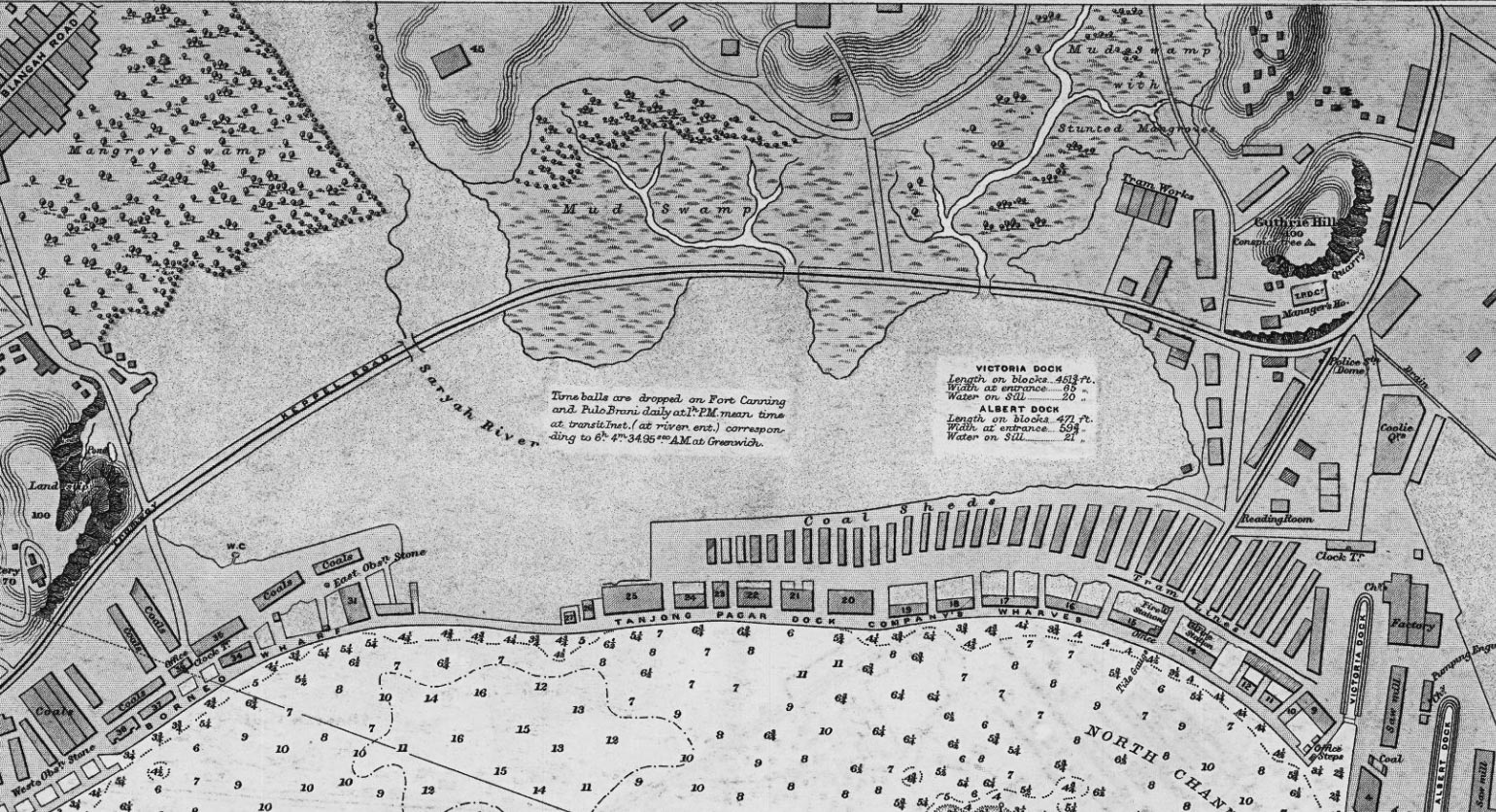
Above: An 1891 map showing both the Singapore Steam Tramway and the 1877 Tanjong Pagar Dock Tramway, the former having just been taken over jointly by the Tanjong Pagar and New Harbour Dock Companies. After they closed the passenger service in 1894 they sold 12 locomotives and all the tramcars but retained 4 locomotives and all the wagons for their continued use. The reports of the 1870s suggested that the tramlines ran the full length of the coal sheds for a distance of 1 mile and certainly by 1909 the line extended to Borneo Wharf as per the map below.
Below: a 1906-1909 map showing the extent of the Tanjong Pagar Dock Tramway. The old Steam Tramway lines and depot are also shown but by this time part of the old tramway has been removed as have the tram lines into the depot which is now part of the SHB complex. For a year or two the Electric trams followed the steam lines along Keppel Road but by the time of this map they had been relayed on the New Keppel Road which is identified by the red line. Also the old Keppel Road has been covered by the new road north of the proposed Lagoon. It would appear that for a short period the two tramways may have shared a short section between Anson Road and the sheds on the north side of old Keppel Road. This was clearly a projected overlay on the 1906 map.
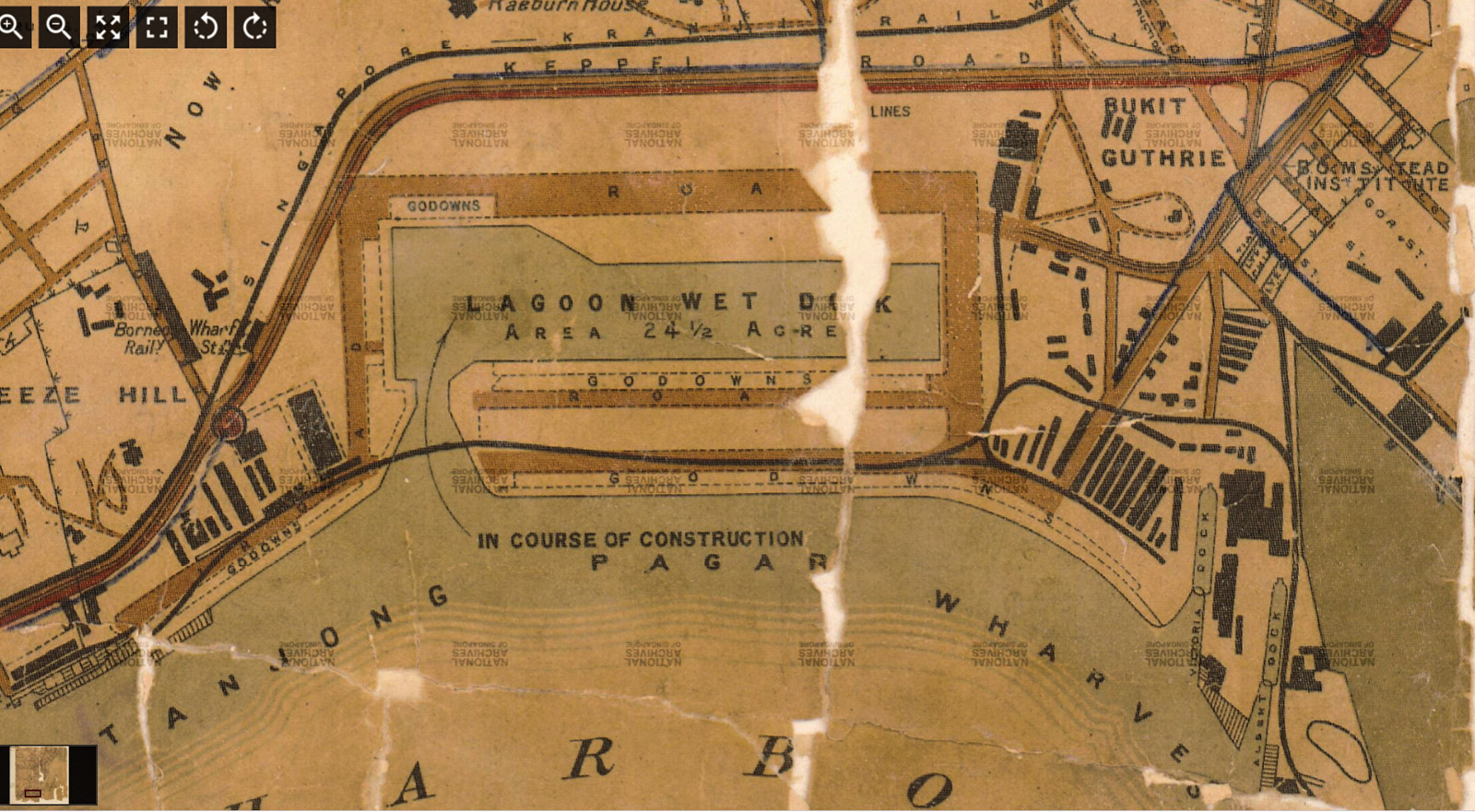
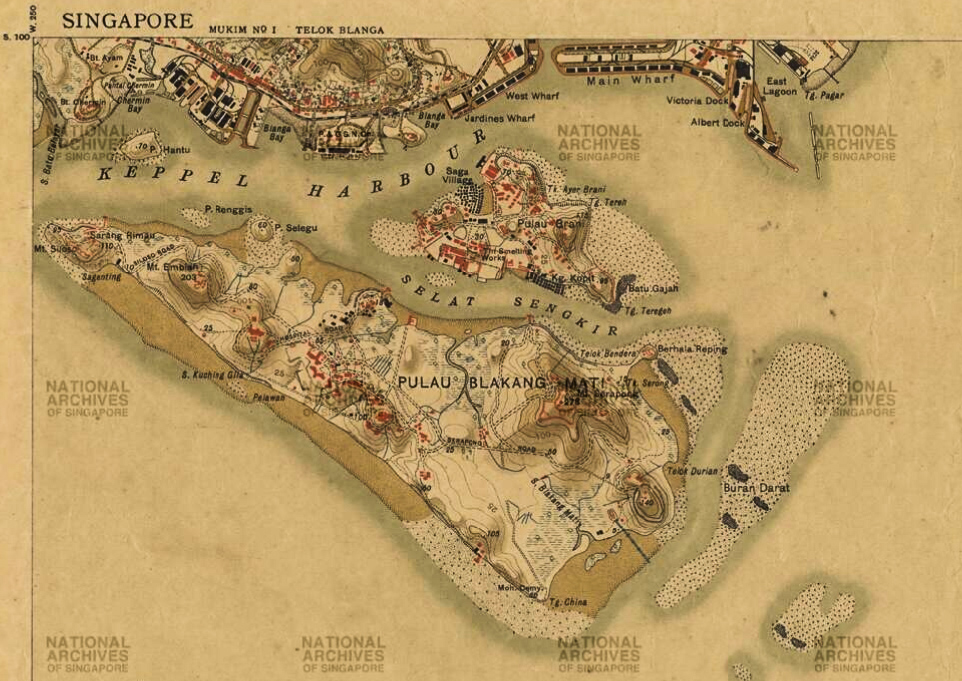
Above: The only map I have at the moment showing the Sidings off the Pasir Panjang branch into New Harbour.
Below: This is the best I can do for the 1924 sidings at Tanjong Pagar with the line hiding behind the P of Pagar in the lower right area.
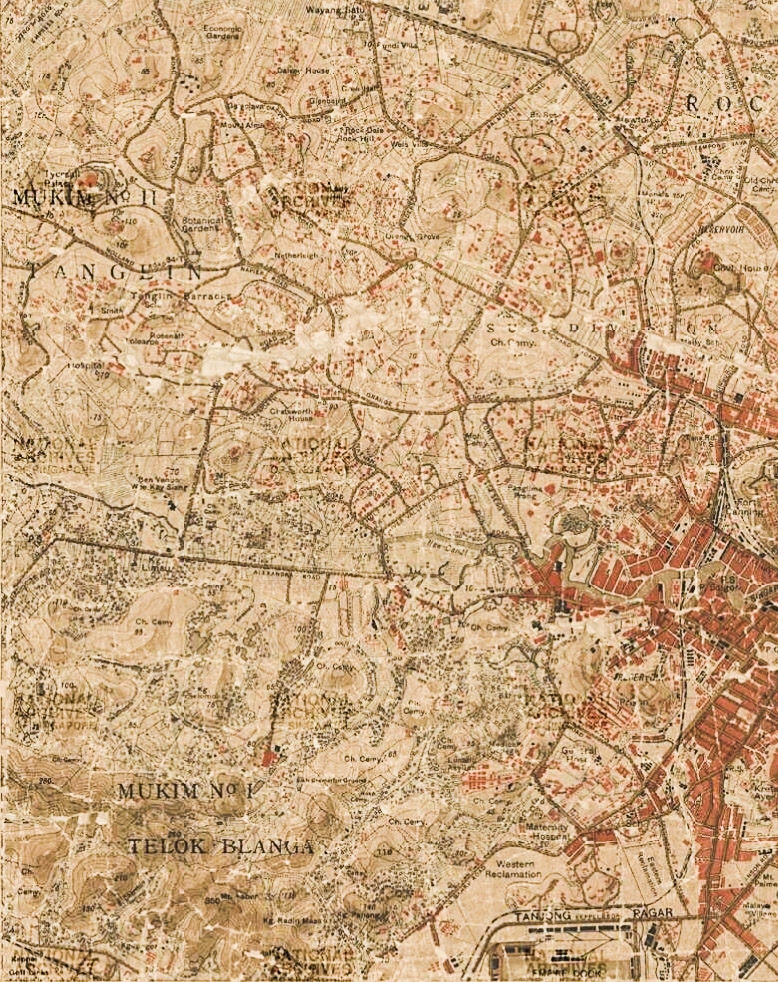
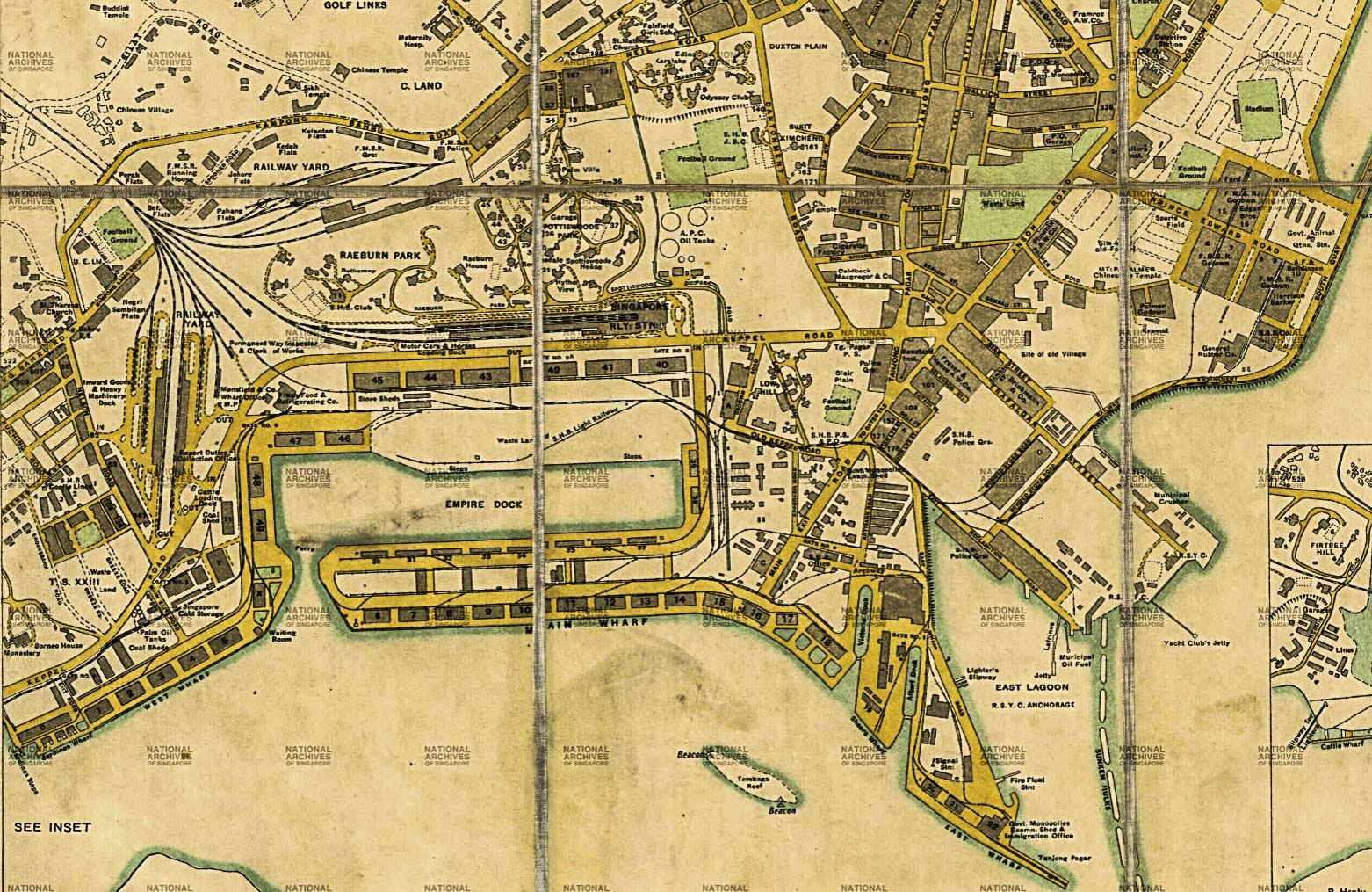
Parts of a 1934 map showing the full extent of the SHB network at Tanjong Pagar , above, and at Keppel Harbour, below. This map shows the realignment of the old line to Pasir Panjang to the south side of Keppel Road after the opening of the new deviation, thus doing away with the level crossing.
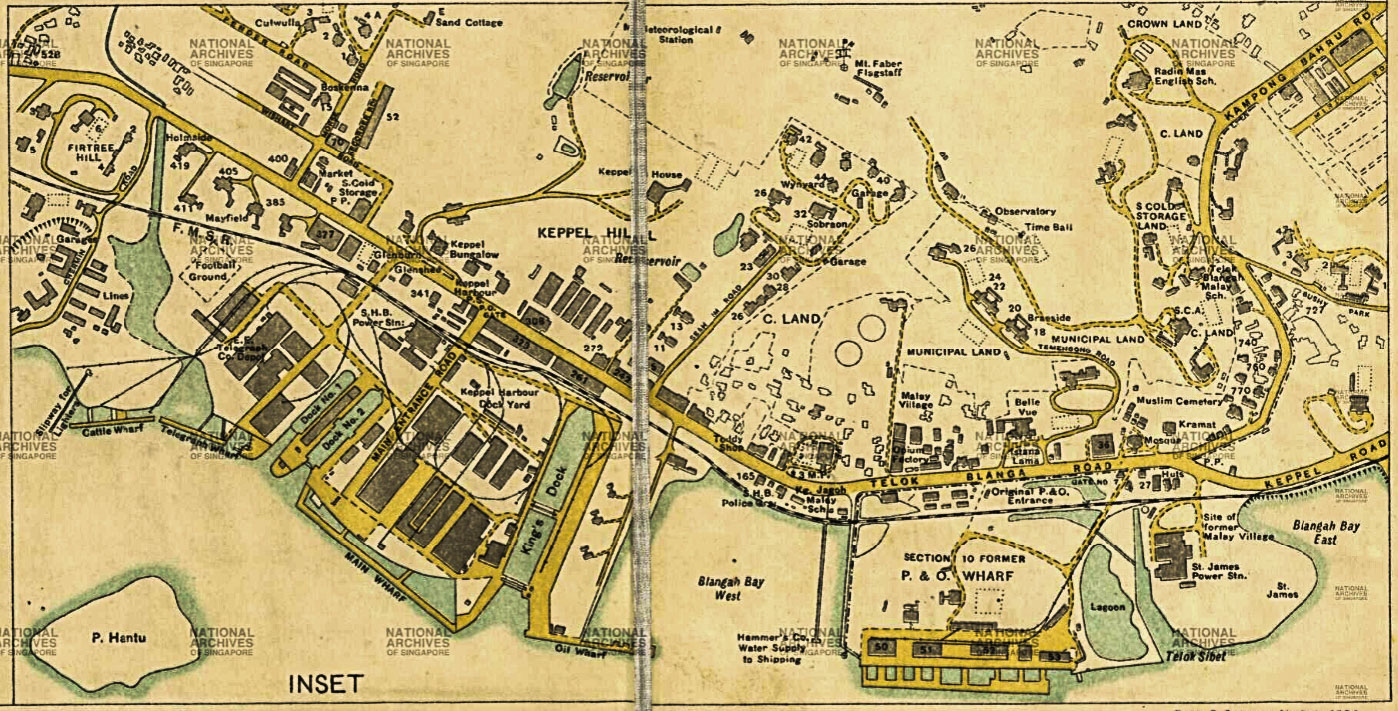
John Aird & Co. supplied them with at least 7 saddle tank locomotives of 0-4-0 and 0-6-0 wheel arrangement from Manning Wardle. They also had at least 5 0-4-0STs built by R Stephenson between 1904 and 1909. Four Manning Wardles were delivered new in 1908/9 while the others were second-hand from UK contracts, having been converted to metre gauge by about 1921/2. In 1933 they took ownership of two Hawthorn Leslie locomotives which were working in Mandai quarry and supplying granite to the Harbour. In September 1946 they purchased 3 Hunslet A class 0-6-0Ts from FMSR, who had acquired them from the Sembawang Naval Base in November 1941. In 1947 an 0-6-0ST numbered 3 was seen there, at first thought to be Peckett but now Avonside as it was transferred from the Naval Base by Topham, Jones & Railton. This would make it the same class as SL7 & SL8 in the military section. Click here for my current listing. By the time of my visits there in the 1970s only diesels could be seen.
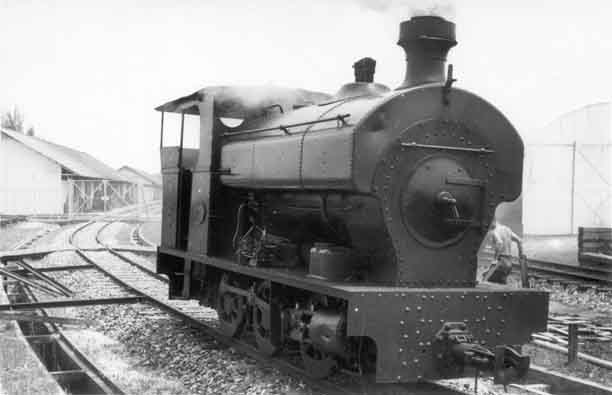
SL7, an Avonside 0-6-0ST similar to No 3 of the SHB, at the Military complex. © Brian Raybould
Tanjong Pagar Dock Company Locomotive listing
1 Dick & Stevenson ?/1877 0-4-0ST no cab
2 Dick & Stevenson ?/1877 0-4-0ST with cab
? Kitson ???/1885-7 0-4-0Tr ex Singapore Tramways, acquired 16 locomotives but later sold 12, some may have gone on to Penang Tramway
? R Stephenson 3122/1904 0-4-0ST
? R Stephenson 3123/1904 0-4-0ST later to Singapore Harbour Board as SHB 3
? R Stephenson 3213/1906 0-4-0ST later to Singapore Harbour Board as SHB 4
? R Stephenson 3346/1907 0-4-0ST later to Singapore Harbour Board as SHB 5
? R Stephenson 3375/1909 0-4-0ST later to Singapore Harbour Board as SHB 6
The above assumes that whereas the government took over the Tanjong Pagar Dock Company in 1904 the Singapore Harbour Board was not formed until 1912.
Singapore Harbour Board Locomotive listing
initial fleet taken over from Tanjong Pagar Dock Co in 1912
1 not known may have been any of the first four above
2 not known may have been any of the first four above
3 R Stephenson 3123/1904 0-4-0ST
4 R Stephenson 3213/1906 0-4-0ST
5 R Stephenson 3346/1907 0-4-0ST
6 R Stephenson 3375/1909 0-4-0ST
Additional locomotives acquired after 1912 and given vacant numbers in the series.
1 Hawthorn Leslie 3644/1925 ex Singapore Municipal Council for Mandai Quarry, to SHB in 1933, withdrawn c1954
2 Hawthorn Leslie 3685/1927 ex Singapore Municipal Council for Mandai Quarry, to SHB in 1933, withdrawn c1954
3 Avonside 20xx/1929 0-6-0ST seen there in 1947 but details not recorded
5 Hunslet 1626/1929 0-6-0T ex Malayan Railway 331.01, FMSR 124, Sir John Jackson SL20, to SHB 1946. 2 more of these (331.02 & 331.03) are also thought to have gone to the SHB but details are not known, though they may have been numbered 4 & 6.
7 Manning Wardle 1754/1909 0-4-0ST ex John Aird 326 for Topham, Jones and Railton Singapore Harbour works, to SHB c1918
8 Manning Wardle 1729/1908 0-4-0ST ex John Aird 228 for Topham, Jones and Railton Singapore Harbour works, to SHB c1918
9 Manning Wardle 1495/1900 0-4-0ST ex John Aird 137, ex Std Gauge, to SHB 1921?, later to Penang as HB2
10 Manning Wardle 1588/1902 0-4-0ST ex John Aird 510, ex Std Gauge, to SHB 1921?
11 Manning Wardle 1496 or 1500 0-4-0ST ex John Aird, ex Std Gauge, to SHB 1922?
Hunslet 1624/1929 0-6-0T ex Malayan Railway 331.02, FMSR 126, Sir John Jackson SL18, to SHB 1946
Hunslet 1625/1929 0-6-0T ex Malayan Railway 331.03, FMSR 127, Sir John Jackson SL19, to SHB 1946
Sir John Jackson's Singapore Harbour contract
This had a standard gauge line with two Barclay locomotives named Princess May and Burntisland which were later shipped to Canada (by 15th February 1914).
Barclay 797/1897 Burntisland
Barclay 892/1901 Princess May
John Aird's Singapore Harbour contract (1908-1911)
Topham, Jones & Railton's Singapore Harbour contract (1912-1918)
This contract was awarded to John Aird in 1908 to build a new dock on swampland at Tanjong Pagar. It involved the realignment of Keppel Road to run parallel to, and just south of, the railway line from Tank Road to Pasir Panjang between Anson Road and Borneo Wharf. A new dock, known as Empire dock, was then dug out with wharves on the north, east and south sides with the opening to the sea at the south-west corner, near Borneo wharf. The contract included building the King's Dock, a Graving (or Dry) dock, which was opened on 26th August 1913.Much of the granite for the works came from Mandai Quarry (see below). John Aird supplied a small fleet of Manning Wardle 0-4-0STs. The locomotives for this work came from Gibraltar dockyard and were originally built to Standard gauge. Following strikes and subsequent court actions the contract was terminated in 1911 and awarded to Topham, Jones & Railton.
Manning Wardle 1729/1908 0-4-0ST metre gauge, new to John Aird as 228, later to SHB 8
Manning Wardle 1730/1908 0-6-0ST metre gauge, new to John Aird as 233, named MALACCA, later to Prai Wharves
Manning Wardle 1731/1908 0-6-0ST metre gauge, new to John Aird as 234, named MUDA, later to Prai Wharves
Manning Wardle 1754/1909 0-4-0ST metre gauge, new to John Aird as 326, later to SHB 7
Bagnall 1472/1895 0-4-0T metre gauge, ex Gibraltar dockyard, in use 1909-1918
Bagnall 1473/1895 0-4-0T metre gauge, ex Gibraltar dockyard, in use 1909-1918
Manning Wardle 1465/1899* 0-4-0ST metre gauge, ex Gibraltar dockyard, in use 1909-1918, named GIBRALTAR; later to Malacca
Manning Wardle 1496/1900 0-4-0ST Std Gauge, ex John Aird, Millom, in use 1912-1918, parts to SHB 11 in 1922
Manning Wardle 1500/1900 0-4-0ST Std Gauge, ex John Aird, Millom, in use 1912-1918, parts to SHB 11 in 1922
Manning Wardle 1550/1901 0-4-0ST metre gauge, ex Gibraltar dockyard, in use 1909-1918
*Manning Wardle 1465 had previously been identified as 1446 in a letter to IRS 55 but this was working in Newcastle. Manufacturing records show that 1465 was shipped to Gibraltar with the nameplate GIBRALTAR and was later sent to Singapore in 1909.
It is possible that there was some interchange between the two systems. SHB11 was metre gauge and incorporated parts from both locomotives, which may have been converted to metre gauge before being used on the dock works.
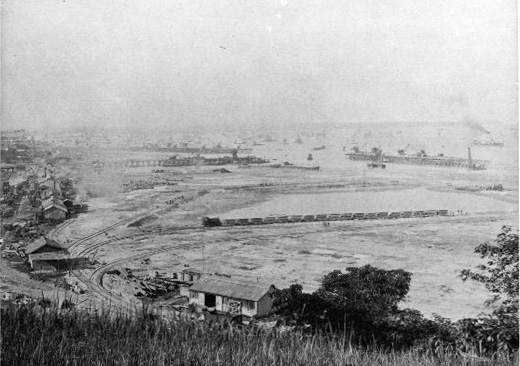
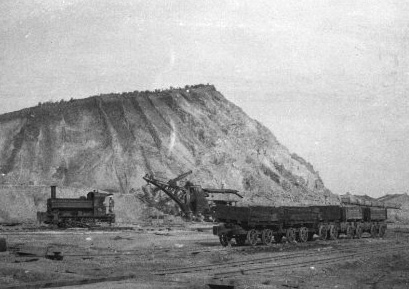
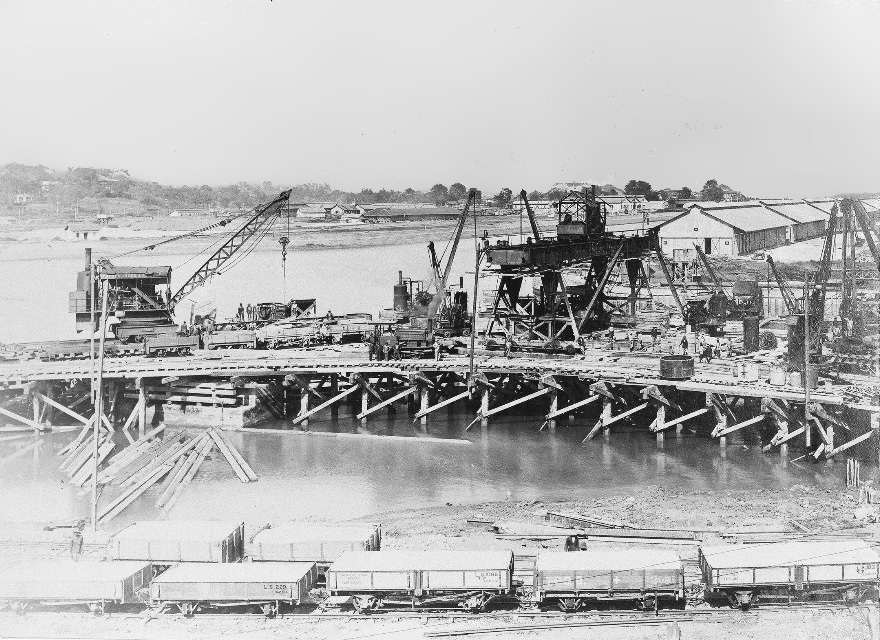
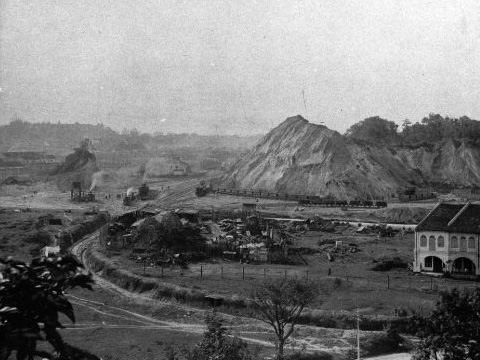
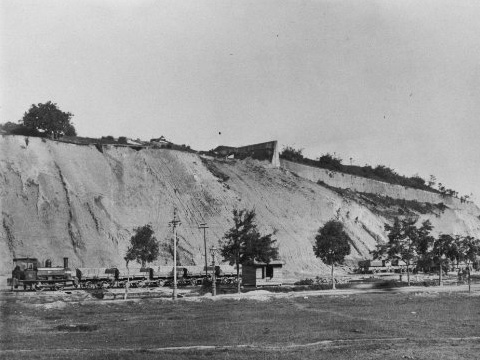
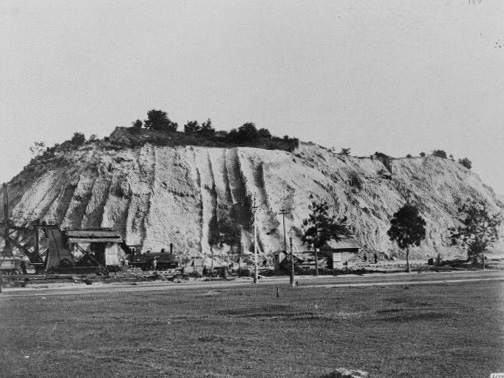
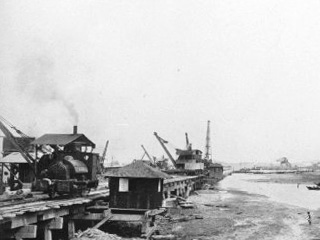
The locomotives in the above pictures are believed to be Manning Wardle tanks with the possible exception of the last one which might be a Bagnall.
Sir John Jackson's Sembawang Naval Base contract
Locomotives used in the construction
Avonside 2024/1929 0-6-0ST SL 1 to RN base as M1
Avonside 2025/1929 0-6-0ST SL 2 to Burma Railway as SL2
Avonside 2026/1929 0-6-0ST SL 3 to Burma Railway as SL3
Avonside 2027/1929 0-6-0ST SL 4
Avonside 2028/1929 0-6-0ST SL 5
Avonside 2029/1929 0-6-0ST SL 6 to RN base as SL6
Avonside 2030/1929 0-6-0ST SL 7 to RN base as SL7, later to Ayer Rajah base near Tanglin as SL7
Avonside 2031/1929 0-6-0ST SL 8 to Ayer Rajah base near Tanglin as SL8
Avonside 2032/1929 0-6-0ST SL 9
Avonside 2033/1929 0-6-0ST SL 10 to RN base
Avonside 2034/1929 0-6-0ST SL 11
Hunslet 1622/1928 0-6-0T SL 16 to Malayan Collieries as MC 1
Hunslet 1623/1928 0-6-0T SL 17 to Malayan Collieries as MC 4
Hunslet 1624/1928 0-6-0T SL 18 to FMSR as 126, later 331.02; to SHB as SHB5 in 1946
Hunslet 1625/1928 0-6-0T SL 19 to FMSR as 127, later 331.03; to SHB in 1946
Hunslet 1626/1928 0-6-0T SL 20 to FMSR as 124, later 331.01; to SHB in 1946
Hunslet 1627/1928 0-6-0T SL 21 to Malayan Collieries as MC 8
Hunslet 1628/1928 0-6-0T SL 22 reported to Malayan Collieries but no record there
Hunslet 1629/1928 0-6-0T SL 23 reported to Malayan Collieries but no record there
Hunslet 1630/1928 0-6-0T SL 24 to Malayan Collieries as MC11
Hunslet 1631/1928 0-6-0T SL 25 reported to Malayan Collieries but no record there
Hunslet 1632/1928 0-6-0T SL 26 to Malayan Collieries as MC 9
Hunslet 1633/1928 0-6-0T SL 27 to Malayan Collieries as MC10
Hunslet 1634/1928 0-6-0T SL 28 reported to Malayan Collieries but no record there
|
This was a large user of rail traffic on both metre and standard gauges. It is not clear whether the metre gauge line was connected to the FMSR line during construction. To obtain sufficient concrete, a new granite quarry was opened at Bukit Lunchu (or Lunchoo), on the Johore side of Old Strait, opposite the dockyard site. A total of 1,600,000 tons of granite stone was brought down to the Straits by a special railway constructed for this purpose, and shipped across to the dockyard on barges. I have yet to establish the gauge of this railway. There were 24 metre gauge locomotives, 13 0-6-0Ts with outside cylinders from Hunslet (3 of which became FMSR A class and passed on to the Singapore Harbour Board) and 11 0-6-0STs from Avonside (two, SL 2 & SL 3, went to Burma; two, SL 7 & SL 8, to the Military and at least one to the SHB). One of the standard gauge locomotives was Hawthorn Leslie 3865/1936 which is still extant today - see the Military page. The build date suggests it was not used for the construction. |
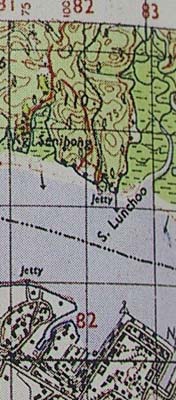 |
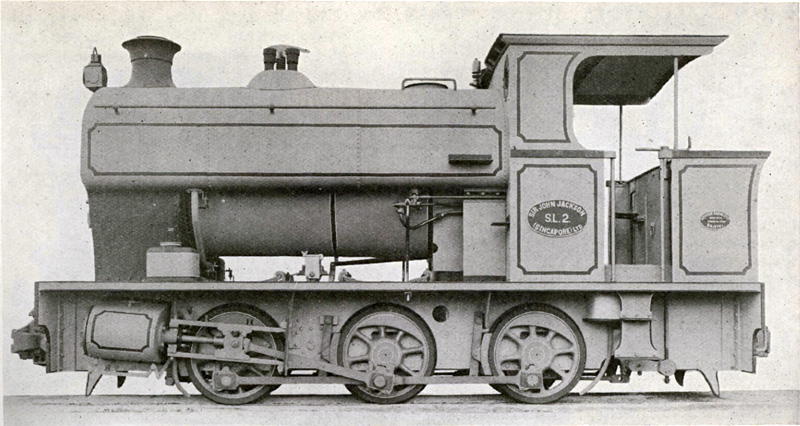
Above: a works photo of SL 2, Avonside 2025/1929. This locomotive went to the Burma Railways with SL 3 after completion of the Naval Base contract.
Below: 3 of the locomotives en-route from the Avonside works to the docks at Bristol.
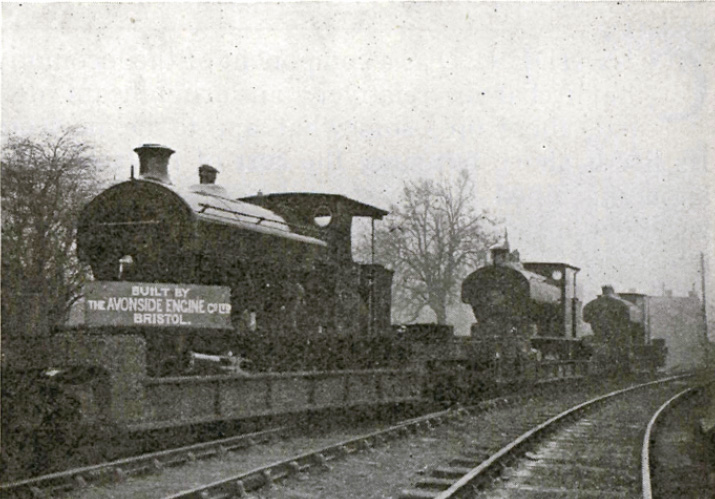
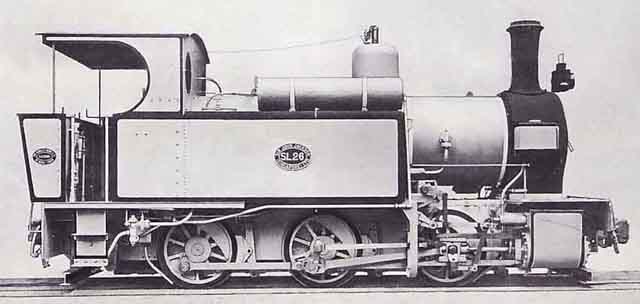
Above: SL 26, Hunslet 1632/1928, one of the locomotives supplied to Sir John Jackson for the Naval Base contract, and the same class as those sold on to the FMSR and Singapore Harbour Board. This one became Malayan Collieries MC 9.
Below: Hawthorn Leslie 3865 at work in Singapore.
Public Works Department, Straits Settlements
1. Construction of Kallang Airport
This was a 3' gauge line using Hudswell Clarke 1625 of 1928 and 13 Peckett 0-6-0STs (1841-51/1932 and 1865/6). By the time of the Japanese occupation at least one if not both Manning Wardle locomotives (1985 & 1986/1920) were working on this line. The fate of this line and the stock is not recorded but it is possible that it was all moved to Changi for constructing the airfield there during the Japanese occupation.
Sand was excavated from a quarry at Kampong Batak (now the site of Bedok reservoir) and transported by rail to Kallang Basin. A map held in the British Library archives shows the railway running southwards and westwards in stages from the quarry to cross Jalan Eunos where there was a spur into a shed and then continuing southwards and westwards to Kallang basin where it crossed the swamp
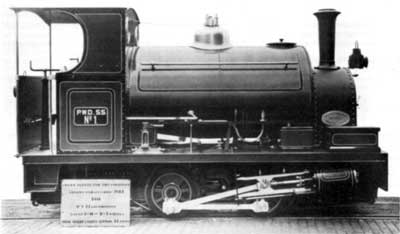
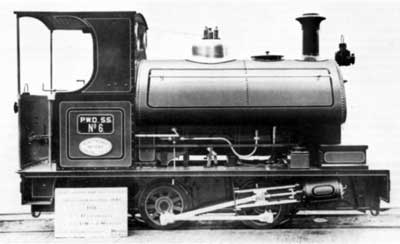
Above: Public Works Department Straits Settlements No 1 (Peckett 1841/1928) left and No 6 (Peckett 1846/1928) right.
Below: Manning Wardle 1985 and 1986 at Abertillery before being sold to Singapore, they were last recorded at Kallang airport just before the Japanese invasion.
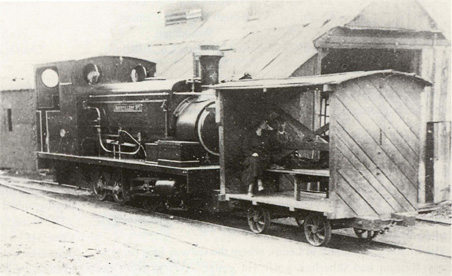
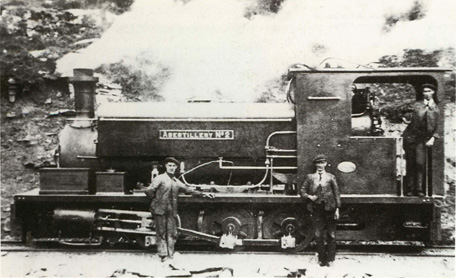
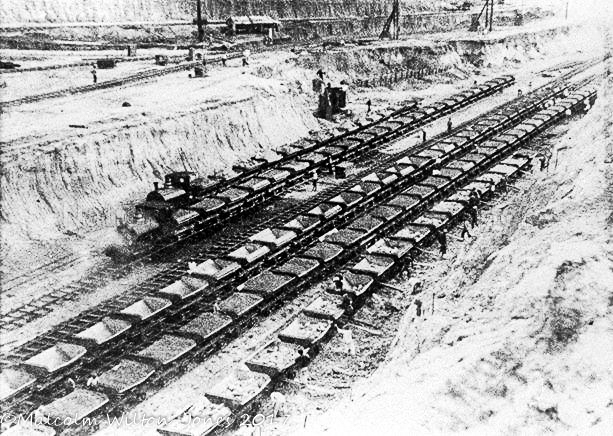
Above: Two Peckett 0-4-0T locomotives, presumably at the sand quarry.
Below: Map of the Railway from the earth quarry near the top right corner to the airport site in the bottom left corner. Note the siding just after it crosses Jalan Eunos, this is most likely the site of the locomotive depot close to the quarry as the line runs through swamps on the site of the airfield. The original airfield was the 1 km circle as shown but after the swamp was reclaimed and the land settled the runway was extended across the swamp for a total length of 1675 metres (5496').
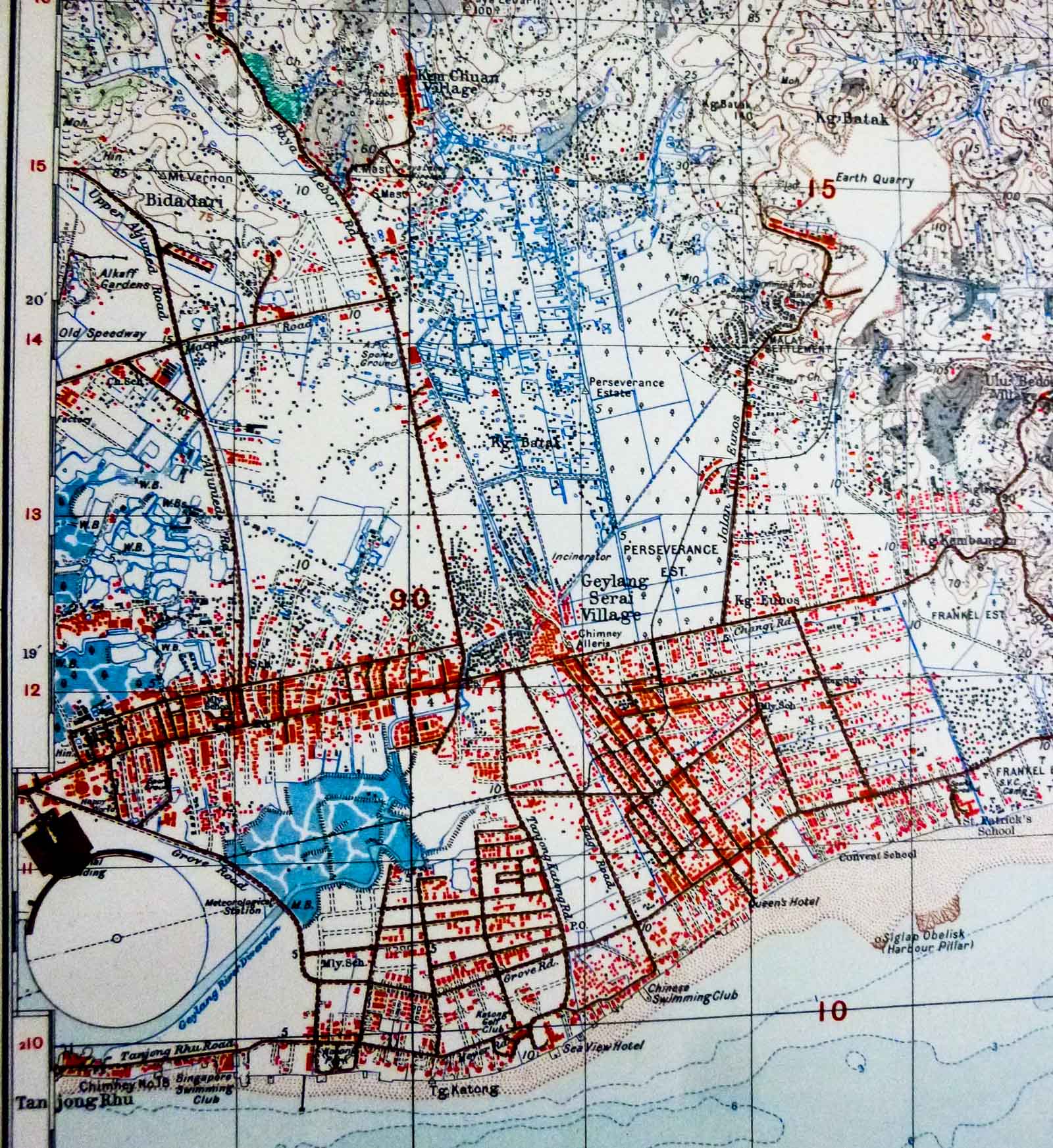
2. Alkaff gardens cemetary railway.
For a long time there were remains of another railway at the nearby Alkaff gardens reportedly used for transporting coffins at a cemetary. It is just visible on the extreme left of the map above
3. Serangoon sewage railway.
There was a sewage treatment works near Bidadari which had pipelines and a railway from that point northwards to the swamp area near the mouth of the Serangoon river.
To clarify a little more, the railway first
appears on a 1947 map compiled by Indian military surveyors and runs from the
then new Kim Chuan sewage works to the swamps at the mouth and east of the the
Serangoon river. It may have been for the construction of the parallel pipelines
which appeared later between these two points or may have been used for the
transport of sludge from the treatment works to the swamps where the later
Serangoon treatment works were. Some interim maps show both the railway and the
pipelines running alongside the north-west border of the Paya Lebar airport both
during and after construction of said airport. Other than maps I have not yet
found any mention of this railway.
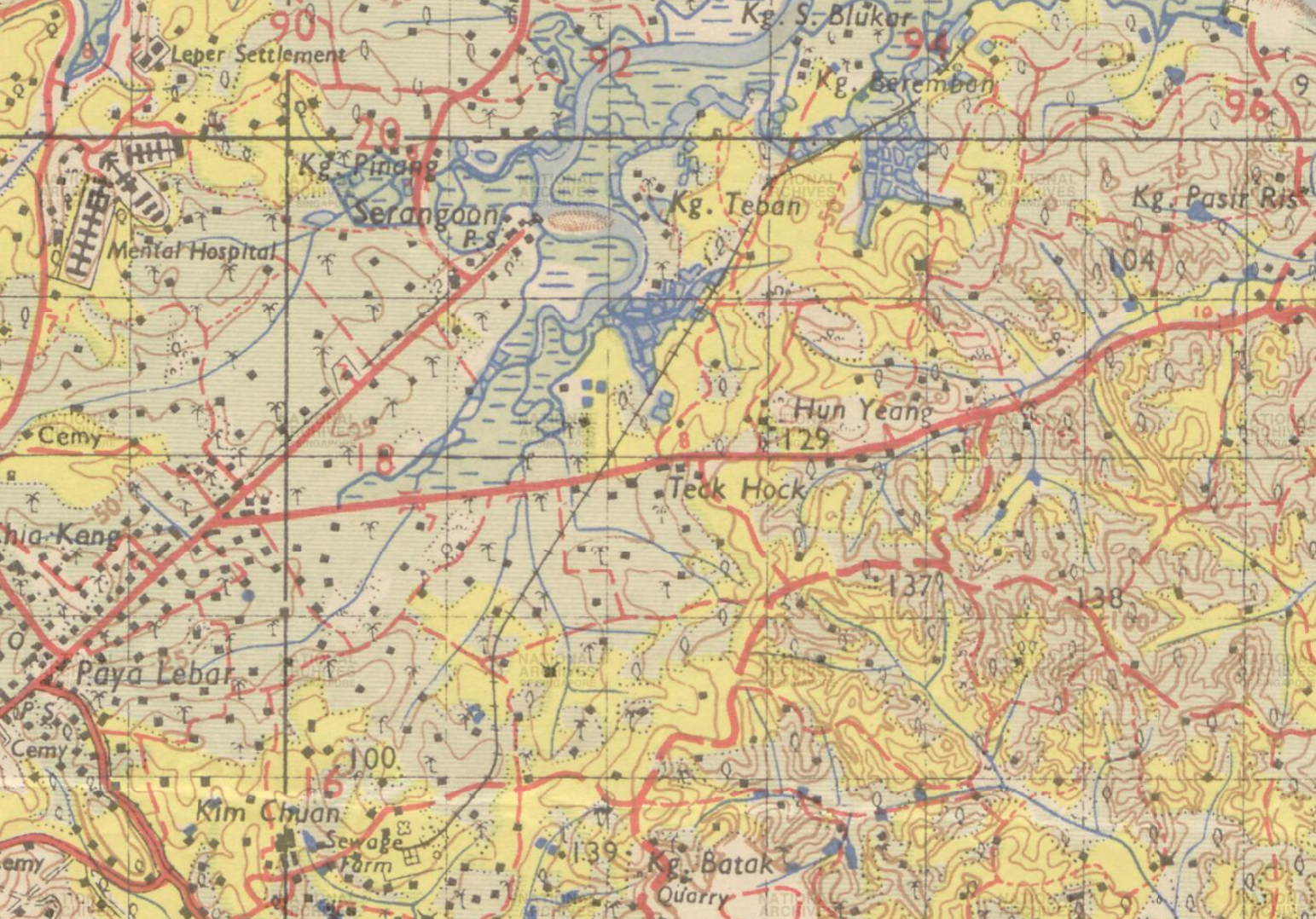

Petrol locomotive at the northern terminus of the Serangoon sewage railway, © Fred W York, mid 1950s.
The Mandai Quarry
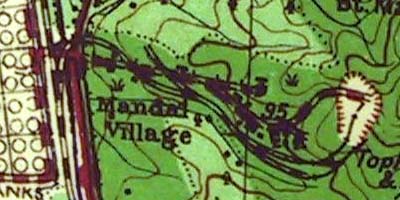
This was jointly owned by the Singapore Municipal Council and the Singapore Harbour Board. The land was acquired in 1920-21 and quarrying operations commenced in 1925 when the metre gauge quarry railway was connected to the FMSR main line. Two locomotives were purchased from Hawthorn Leslie in 1925 and 1927 for use in the quarry and these were maintained by the Singapore Harbour Board, who supplied additional motive power when required. Most of the granite was required by the Singapore Harbour Board and in 1935 they took over the whole operation including the locomotives.
Below is a 1924 map showing the siding as
originally built. Later maps show several additional sidings. It is thought that
the track may have been taken by the Japanese for use on the Burma Railway. No
information has surfaced regarding the use of rail to/from or within the quarry
since WWII and it is not shown on the 1947 survey map.
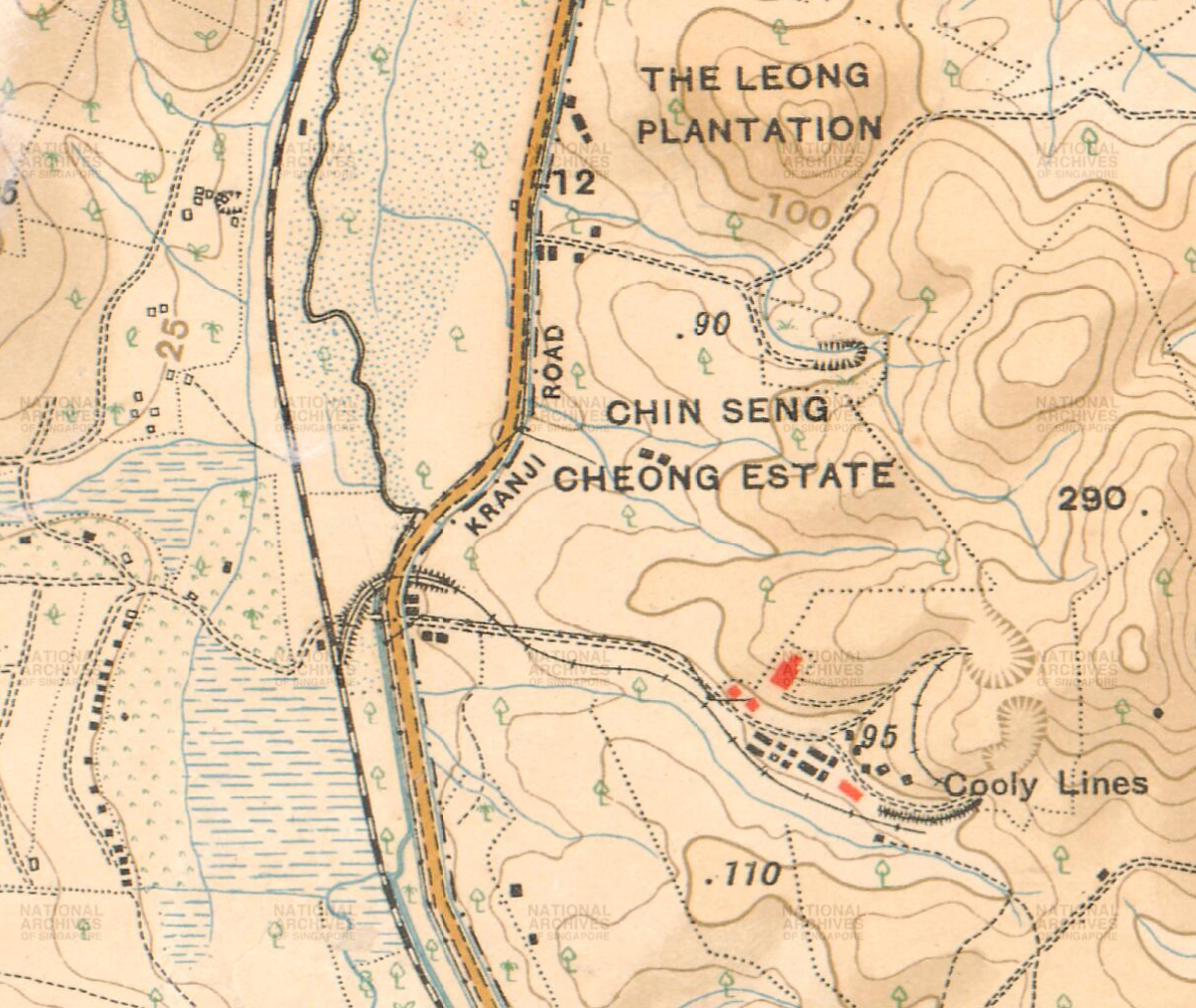
Causeway construction
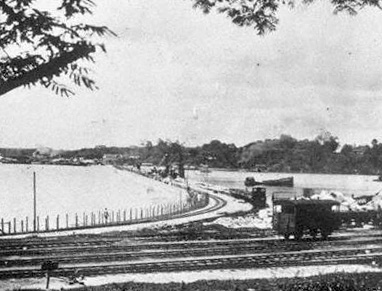
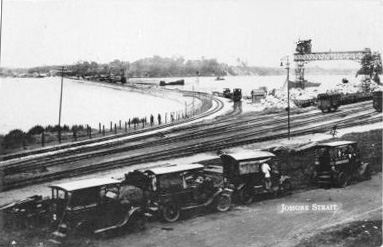
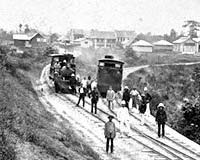 |
The two photographs above were taken from Woodlands, probably in 1922 as the work appears to be well advanced. Woodlands station is just to the left of the picture and the lines on the right are sidings. The vehicles in the right-hand picture appear to be Ford model T 7-seater "mosquito buses", probably waiting to return workers to their homes. The contractors were Topham, Jones & Railton. Construction commenced in 1920 and took 3 years. The old photograph on the left was captioned "Johore Causeway" but it actually shows the Selangor Government Railway station and goods yard in Kuala Lumpur and was taken c 1886. The full picture with many others will appear on my History of railways around Kuala Lumpur which is currently under construction.
|
Locomotive listing for causeway works
Manning Wardle 1119/1889 0-6-0ST Std Gauge K class GOWY ex Swansea 1921, returned 1925
Manning Wardle 1331/1897 0-6-0ST Std Gauge L class WYMONDLEY ex UK, returned by 1927
Manning Wardle 1413/1898 0-6-0ST Std Gauge H class KELANTAN
Manning Wardle 1461/1899 0-6-0ST Std Gauge H class KEDAH scrapped 1927
Manning Wardle 1579/1902 0-6-0ST Std Gauge L class PAHANG returned to UK by 1929
Manning Wardle 1585/1902 0-6-0ST Std Gauge L class PERAK
| In 1928 Atkinson Walker supplied
four of these metre-gauge vertical-boiler chain driven rail tractors to
the Singapore Municipal Council. They had works numbers 105-108.
Interestingly, the above picture of No 2 in the Locomotive magazine for
1928 has very different bodywork to number 4 in the picture on
the right, which appears to be a works photograph when new. I have yet to find any details of where they
were used, but the Council was responsible for the provision of water,
electricity, gas, roads and bridges and street lighting. It is also known
to have been involved with large construction projects, similar to Kallang
airport, which had a 3' gauge railway (see above). Previously, in 1927, Sentinel had shipped an 0-4-0 steam railcar to the Singapore Municipal Council but nothing more is known about this. |
 |
This page created 2nd September 2006
Updated 2nd October 2021
This page has been visited times.